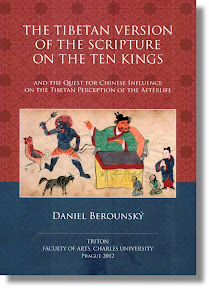The Tibetan Version of the Scripture on the Ten Kings
Berounský, Daniel:
The Tibetan Version of the Scripture on the Ten Kings : and the Quest for Chinese Influence on the Tibetan Perception of the Afterlife / Daniel Berounský ; with a comparative description of the paintings by Luboš Bělka. - Prague : Triton ; Faculty of Arts, Charles University, 2012. - 319 S. : Ill.
ISBN 978-80-7387-584-8
CZK 250,00
EUR 17,60 (Kubon & Sagner)
DDC: 294.3423
Beschreibung
The book starts with an outline of the Indian ideas about the hells. Buddhist ideas of the infernal realms are not unique in the Indian subcontinent, but could be seen more as a particular Indian version of the vision of hells among a number of others. This part is concluded with the translation of a vivid example of an abhidharma text from 13th-century Tibet.
The next part of the book is devoted to the genre describing the stories of 'retumers from hells' in Tibet ('das log shi log), the literature which speaks about the hells from a different viewpoint and comes closer to domain of folk religion in Tibet. The main focus of this part is instead the generally neglected relation of such Tibetan stories to their much earlier Chinese counterparts. With the translation of one such stories, that of Lingza Choekyi, this section comes to an end.
What follows in the next part is a discussion of one particular narration, this being Maudgalyāyana's rescue of his mother from the hells. It is probably a Chinese apocryphal text, one well-known example of the genre of prosimetric texts known as bianwen in China. The apparent variability of the titles of these texts in their Tibetan versions is dealt with. One arrives at a picture of relatively wide knowledge about this particular story in Tibet.
The find in the National Gallery in Prague, which is the Tibetan rendering of another Chinese apocryphal text, The Scripture on the Ten Kings is introduced and translated then. This manuscript seems to be the first instance of such a version ever to be discussed. The provenience of the text remains uncertain. Bearing the cases of delog and Maudgalyāyana in mind, there is a possibility that The Scripture on the Ten Kings was known in Tibet, but being condemned by the elite of educated monks, it remained alive within the lower strata of Tibetan or Mongolian society. Such characteristics as frequent spelling mistakes in the manuscript or errors in the parts concerning the doctrine clearly suggest the likeliness of such an origin for the text. [Vom Umschlag]
Inhalt
Acknowledgments. 9
Introduction. 10
Abbreviations and standard references. 16
I. INDIAN IDEAS ABOUT THE HELLS. 19
The Tibetan heritage of Indian Buddhist notions of hells. 20
Teaching Concerning the Places of Dwelling of the Sentient Beings (translation). 33
II. RETURNING FROM HELLS. 43
Visits to the hells: Tibetan delog narrations and Chinese zhiguai stories. 44
A Brief Hagiography of the Delog Lingza Choekyi (trans1ation). 53
III.MAUDGALYĀYANA'S TRAVELS IN HELLS. 77
Chinese settings. 78
The Tibetan versions. 86
The Tibetan reworking of the story: The Sūtra of Lhabu Pematrul. 100
The Noble Sūtra called the 'Wholly Saving Vessel' (transIation). 116
Story of Maudgalyāyana's mother by Sonam Lhay Wangbo (translation). 121
List of Tibetan manuscripts of the story on Maudgalyāyana's rescue of his mother. 126
IV. TEN KINGS OF THE AFTERLIFE. 131
Chinese Scripture on the Ten Kings. 132
The Prague collection of the texts containing the Tibetan manuscript of The Scripture on the Ten Kings. 141
The Prague Tibetan version of The Scripture on the Ten Kings. 148
Remarks on the possible influence of the text in the Tibetan milieu. 158
The Tibetan version of The Scripture on the Ten Kings (translation). 163
1. Introductory Verses and Colophon. 164
2. Prophecy of Buddha and Perfomancee of the Feasts. 166
3. The Ten Lords of the Dead. 186
4. The Condensed Heart Sūtra. 208
5. Concluding Parts. 216
6. Maitreya's Dhāraṇī. 219
Concluding remarks. 263
Appendices. 269
Color plates of the scenes of the king's courts. 269
Comparative description of the paintings. 275
References. 298
Index. 309
Autor
DANIEL BEROUNSKÝ, Seminář mongolistiky a tibetanistiky, Institute of South and Central Asia, Charles University, Prague.
Quellen: Knihkupectví Karolinum; Kubon & Sagner; Filozofická Fakulta, Univ. Karlovy v Praze
Berounský: The Tibetan version of the scripture on the Ten Kings, 2012
Ähnlich
- Rakow: Transformationen des tibetischen Buddhismus
- Tiso: Liberation in One Lifetime
- Dalai Lama V.: The Illusive Play
- Sihlé: Rituels bouddhistes de pouvoir et de violence
- Zivkovic: Death and Reincarnation in Tibetan Buddhism
- Monastic and Lay Traditions in North-Eastern Tibet
- Schneider: Le renoncement au féminin
- Smith: The Monasteries of Amdo
- Quintman: The Yogin and the Madman
- Butön's History of Buddhism

